
In this video segment from Nature, crabs face numerous obstacles in their migration from their forest home to the Caribbean Sea. [4:09]
- Subject:
- Science
- Material Type:
- Audio/Video
- Lesson
- Provider:
- PBS LearningMedia
- Date Added:
- 12/01/2022

In this video segment from Nature, crabs face numerous obstacles in their migration from their forest home to the Caribbean Sea. [4:09]

A succinct overview of basic grammar terms with links to lessons; written by a high school English teacher.
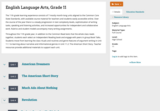
The 11th grade learning experience consists of 7 mostly month-long units aligned to the Common Core State Standards, with available course material for teachers and students easily accessible online. Over the course of the year there is a steady progression in text complexity levels, sophistication of writing tasks, speaking and listening activities, and increased opportunities for independent and collaborative work. Rubrics and student models accompany many writing assignments.Throughout the 11th grade year, in addition to the Common Read texts that the whole class reads together, students each select an Independent Reading book and engage with peers in group Book Talks. Students move from learning the class rituals and routines and genre features of argument writing in Unit 11.1 to learning about narrative and informational genres in Unit 11.2: The American Short Story. Teacher resources provide additional materials to support each unit.

People often say that mankind should learn from history. Charles Dickens, whose books are considered classics, set his novel A Tale of Two Cities in the past. He wanted his readers to learn from the bloody French Revolution and from the widespread brutality in London. Both cities (Paris and London) offer the reader a glimpse into dark and dangerous times. As students read about Dickens's Victorian setting and learn his view of the French Revolution, they will think about what makes a just world. Students will have a chance to think about their own experiences, and, using techniques they have learned from Charles Dickens, they will do some writing that sends a message about your own world.
ACCOMPLISHMENTS
To complete the unit accomplishments, students will:
Read the Charles Dickens novel A Tale of Two Cities.
Read several short pieces, including a biography of Dickens and excerpts from other literature, to help them understand Dickens’s world and the world of the novel.
Explore new vocabulary to build their ability to write and speak using academic language.
Practice close reading and participate in several role plays and dramatic readings to help them experience the dramatic writing style of Charles Dickens.
Write a vignette and a short narrative piece, and practice using descriptive detail and precise language.
Write a reflection about the meaning of Dickens’s novel.
GUIDING QUESTIONS
These questions are a guide to stimulate thinking, discussion, and writing on the themes and ideas in the unit. For complete and thoughtful answers and for meaningful discussions, students must use evidence based on careful reading of the texts.
How does good storytelling affect the reader, and how can a good story promote change in the world?
What was the Victorian view of gender roles?
How can power be abused?
What is loyalty ? What are the limits of loyalty?
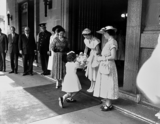
In this lesson, students will focus on grammar as it relates to this section of A Tale of Two Cities.

This site gives short definitions of the terms denotation and connotation. Also gives definitions for many figures of speech. Finally, includes discussion and study questions for a few poems at the bottom of the page. L.11-12.5b Nuance

Learn about similes and metaphors through this multimedia presentation. First view a slide show describing different types of metaphors as well as a simile. Then watch a video [3:13] showing similes and metaphors used in popular songs. A second video [2:02] explains the meanings of popular metaphors/idioms. Finally, view figurative language use in various popular song lyrics and poems.
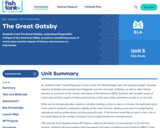
Students read The Great Gatsby, evaluating Fitzgerald's critique of the American 1920s, as well as considering issues of social class and the impact of history and memory on individuals.

A list of figures of speech and their definitions with examples from literature.
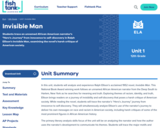
Students trace an unnamed African American narrator's "Hero's Journey" from innocence to self-discovery in Ralph Ellison's Invisible Man, examining the novel's harsh critique of American society.

Definitions and examples of simile, metaphor, and hyperbole followed by 15 sentences asking students to identify whether the sentence contains a simile, metaphor, or hyperbole.
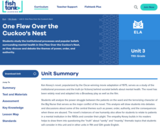
Students study the institutional processes and popular beliefs surrounding mental health in One Flew Over the Cuckoo's Nest, as they discuss and debate the themes of power, order, and authority.

A simple list of literary terms. Click on each for a definition and examples.

How do metaphors help us better understand the world? What makes a good metaphor? Explore these questions in this video with writers like Langston Hughes and Carl Sandburg, who have mastered the art of bringing a scene or emotion to life. Free registration is required to have full access to these lessons.
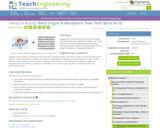
Students learn how scientific terms are formed using Latin and Greek roots, prefixes and suffixes, and on that basis, learn to make an educated guess about the meaning of a word. Students are introduced to the role played by metaphor in language development.

Excellent teaching resource that attempts to teach poetic concepts to middle schoolers by using riddles. Discusses riddles' use of metaphor, simile, and imagery, and relates these concepts to the students' understanding of poetry. Includes student interactives, worksheets, and handouts.
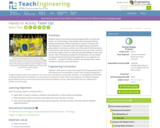
Students explore the physical and psychological effect of stress and tension on human beings. They develop their observing, thinking, writing and teamwork skills by working on a group art project and reporting about it. They learn about the stages of group formation, group dynamics and team member roles that make for effective teams. In the process, they discover how collective action can foster a sense of community support, which can alleviate personal feelings of stress and tension. Note: The literacy activities for the Mechanics unit are based on physical themes that have broad application to our experience in the world concepts of rhythm, balance, spin, gravity, levity, inertia, momentum, friction, stress and tension.
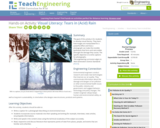
The goal of this activity is for students to develop visual literacy. They learn how images are manipulated for a powerful effect and how a photograph can make the invisible (pollutants that form acid rain) visible (through the damage they cause). The specific objective is to write captions for photographs.

A video [1:15] explaining and giving examples of how to decode similes and metaphors.

An educational video [1:55] that defines and gives examples of metaphors.